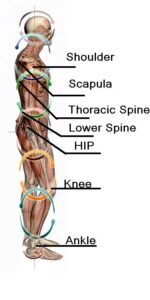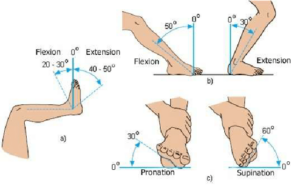“What does my ankle have to do with my knee?”. Well… thank you for asking!
What would a healed ankle injury have to do with knee pain? The answer is EVERYTHING! But since that isn’t a super helpful answer, and I think this part is the most fun, I will elaborate..
I am including resources. If you find that you are curious or skeptical, don’t take my word for it, please click the links!!
The Short Answer
Your knee is a really flexible joint that consists of cartilage, sandwiched between bones, connected by tendons and ligaments. All of these parts are passive, then don’t move on their own or apply force. The major stability in knee comes from muscles above and below the knee. Muscles are what actively apply force. The construction of the knee is like janga or dominos but none of the parts have flat surfaces to rest on. The lower leg bones balance on the ankle bones, the femur balances on a wafer of cartilage in a fluid sack. All of these passive components require contraction of the calf muscles, thigh (quadriceps) and hip muscles to help maintain balance and stability.
The kicker is that our bodies are incredibly adaptable. So if you have an imbalance, your body will find a way to make it work. This is where the pain comes in! If one joint or muscle stops working or changes the way it works the rest of the body will step in and make adjustments to accommodate the change in an effort to find balance.
A healthy comfortable knee requires that the calf and muscles on the front of the thigh can both contract and stretch. If there is a kink in the kinetic chain, for example if the ankle becomes stiff, the calf can’t stretch or contract, and if your calf can’t fully stretch it gets tighter and tighter until it pulls on the knee. A tight or stiff ankle will also shorten your steps preventing full extension of the hip. That is the kinetic chain. If you ankle can’t do it’s share of the give and take then your knee has to do more than it’s share of the work.
Here’s another way to think about it…

This is an image of the kinetic chain.
The energy/force and everything else… circulation, lymph… travel up from the foot to the ankle, to the knee… and on up.
You have three arches in your foot that absorb and dissipate shock << the shock of walking or running carrying you whole body. Each step has an impact. The force that impact transfers from the foot to the ankle and up to the calf.
As your ankle extends (plantar flexion- point your toe) the calf contracts and transfers the force through the knee to the quadriceps.
The arches in your foot are the first line of shock absorption. The calf muscles activation and transfer the shock to your quad, maintaining this balance or flow all the way up your leg.
If a link in the chain becomes stiff or inflexible the weight is transferred up the chain without this important shock absorption or dissipation. This is because the body will find a way to accomplish the task even if the foot or ankle stops working the way it was intended.
The example we started with was the ankle so we will stick with that. If you have an ankle injury that heals and leaves residual ankle stiffness, that ankle stiffness and/or limited range of motion in the ankle will limit the calf muscles ability to contract and extend. This will also result in a shorter stride. With the calf “turned off” the quadricep ability to contract will be reduced creating tightness in the thigh.
Your calf and quadricep play an intricate part in supporting and protecting the knee. The calf also pumps fluid up your leg – keeping build moving can increase comfort in the knee. So what is “normal range of motion”?
https://www.researchgate.net/figure/Normal-values-for-ankle-movements-a-b-flexion-extension-c-pronation-supination_fig1_266558916

This image to the left depicts normal range of motion for the ankle.
Normal range of motion allows enough movement to fully contract and stretch or extend the calf.
The calf muscles help to support the knee. When your calf muscle weaken or don’t activate they leave a weakness and tightness in your knee.
Normal, full range of motion in your ankle allows for your quadricep to function – contract and lengthen with every step.
Try it out, limit your ankle flexibility and walk around for a few paces. Do you notice who the lack of ankle flexibility shortens your stride? As you walk around can you feel your calf and quadricep tighten? Where else in your body do you notice tightening?

Here is a visual of the muscles you feel working. Each of the muscles, in the image to the left has a potential force.
Notice how the calf muscles bulges right into the back of the knee and the thigh muscles insert themselves into the front of the knee.
So if your calf muscle contracts and extends it is actively acting on the knee. You could argue that they help to hold the knee together.
But what if any of the joints isn’t moving at a normal range of motion the muscle don’t have the opportunity to support the knee in the same way.
Now imagine for a moment that one side or area is stiff or tight or shortened? That imbalance would cause a change in the structure.
But the chain doesn’t stop at the knee. The kinetic chain continues up into your hip and up into the low back. You can’t separate the chain, the muscles that continue into the hip also play a big part in knee health and vice versa.
Your body is a complex highly evolved structure that relies on antagonist and protagonist muscles to keep it in alignment and balance. And like any good system the body has enough flexibility to work around nearly any malfunction.
Give your ankles some extra love today and every day!
As you can tell I love this stuff so if you have any questions or see something I missed reach out!